Music notation systems with a chromatic staff and a 6-6 pitch pattern offer a much more accurate representation of interval relationships than traditional notation. The illustrations below show harmonic intervals, but what is being said also applies to melodic intervals. This tutorial is part of a series that includes Intervals in Traditional Music Notation and Reading and Playing Music by Intervals.
In notation systems with a chromatic staff and a 6-6 pitch pattern each interval has its own unique appearance so that there is always a one-to-one correspondence between what one hears and what one sees. This eliminates the ambiguity and inconsistency found in traditional notation. It allows one to grasp the tonal structure of music, its scales, chords, and other patterns, by making these structures explicit rather than implicit.
We will consider three different alternative notation systems and how they represent intervals. Each of these systems takes a different approach to the 6-6 pitch pattern, ‘encoding’ it either in line pattern, notehead color, or notehead shape.
Intervals in Notation Systems with a 6-6 Line Pattern
Our first example is 6-6 Tetragram by Richard Parncutt which has a 6-6 line pattern. At first glance it appears quite similar to traditional notation since intervals are also distinguished by being either being (1) two notes that are both on lines or both on spaces, or (2) a combination of a line-note and a space-note. The difference is that on a chromatic staff this becomes a means to fully identify intervals. For example, the difference between major and minor seconds is clear rather than just the difference between seconds and thirds.
Note that this similarity to traditional notation can also be cause for confusion when switching between the two. For instance what looks like it would be a fifth in traditional notation is a major third in Parncutt’s 6-6 Tetragram. Intervals that look the same when moving from one system to the other are actually not the same interval. This is the case for any 6-6 notation system where the lines are spaced a major second (whole step) apart. So there is a positive and negative aspect to this similarity with traditional notation. We will look at a couple of other notations that address this in different ways.
Chromatic Intervals in Parncutt’s Tetragram Notation
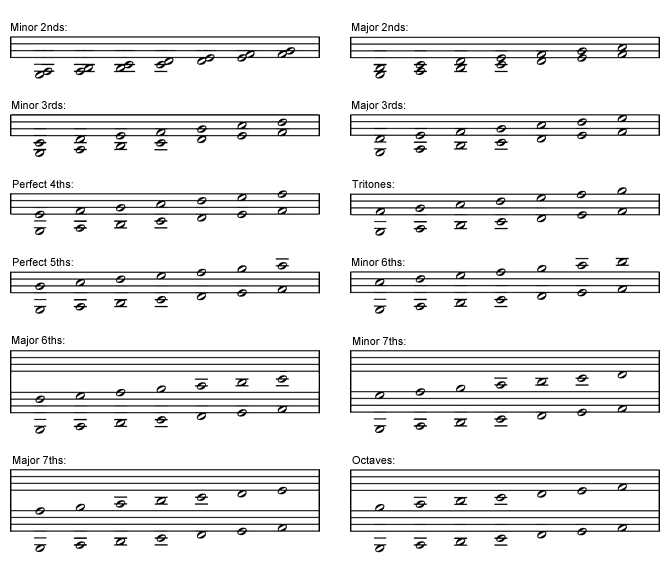
The next illustration shows how the consistency of a 6-6 line pattern makes explicit the differences in diatonic intervals that are obscured by traditional notation.
Diatonic Intervals in Parncutt’s Tetragram Notation, Key of C Major
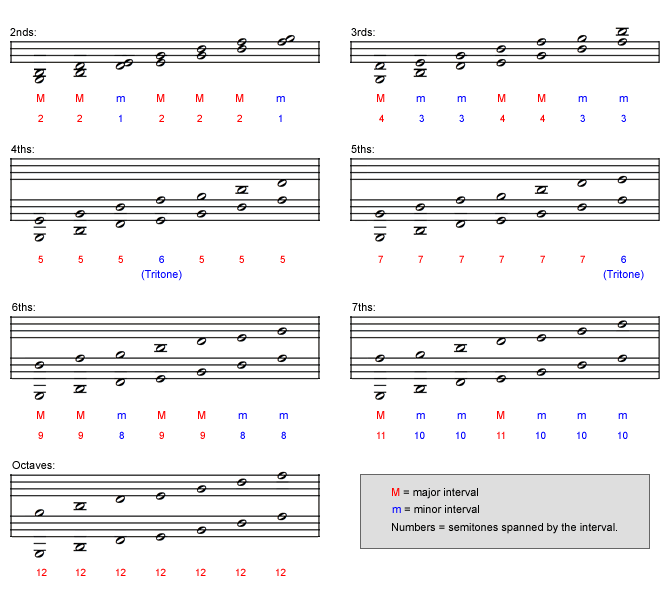
Intervals in Systems with a 6-6 Black and White Notehead Pattern
The next example we will consider is Johannes Beyreuther’s Untitled notation, which has a 6-6 pattern in its noteheads. One whole-tone scale is represented with white/hollow noteheads, and the other is represented with black/solid noteheads (see Noteheads and Pitch). Intervals are distinguished by either being (1) two notes that are both white or both black notes, or (2) a combination of a black note and a white note. This distinction allows one to fully identify any given interval since the intervals have a consistent appearance. However, one drawback to this approach is that there may be confusion from the use of black and white noteheads for pitch rather than rhythm.
Note that the lines are spaced further apart, a major third to be precise. This gives intervals a “wider” appearance than one is used to in traditional notation, and may seem odd at first. This also means that the intervals do not look just like those in traditional notation, while actually being different and sounding different (as we saw with Parncutt’s 6-6 Tetragram above).
6-6 notations that have their lines spaced a major third apart do offer some useful continuity with traditional notation, since the lines in traditional notation are also spaced a third apart (either a major or minor third). This may help make it easier to transition back and forth between the two. For instance, note how major thirds span the same distance as the lines, as is the case in traditional notation. This continuity is not exact, but in general the spacing between intervals and lines will be closer to what one is used to in traditional notation.
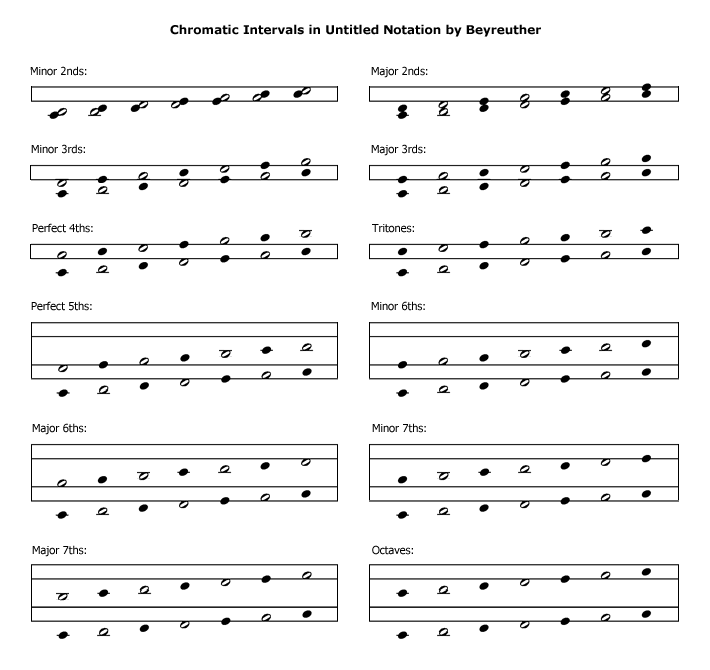
The next illustration shows how the consistency of a 6-6 pattern in notehead color makes explicit the differences in diatonic intervals that are obscured by traditional notation.
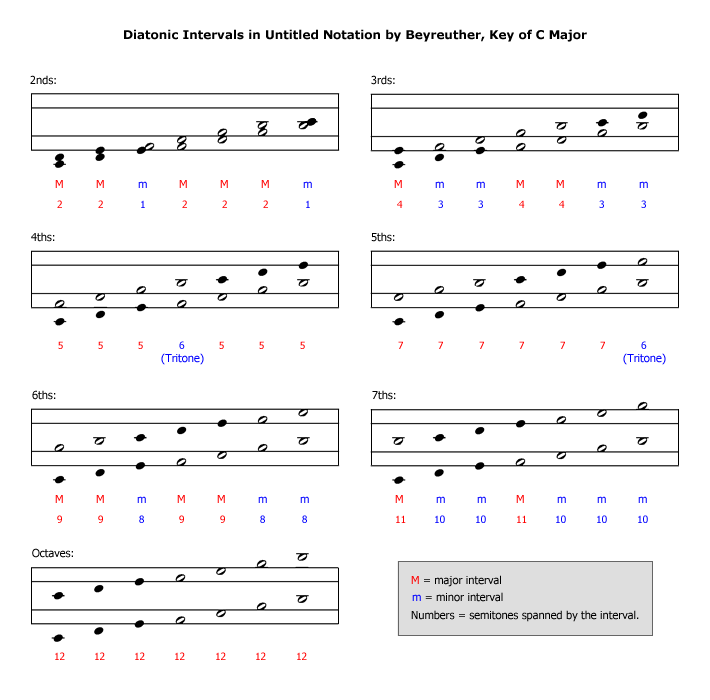
Intervals in Notation Systems with a 6-6 Notehead Shape Pattern
The last example we will consider is Twinline notation by Thomas Reed, which has a 6-6 pattern in its notehead shapes. One whole-tone scale is represented with oval noteheads, and the other is represented with triangular noteheads. Intervals are distinguished by either being (1) two notes that are both ovals or both triangles, or (2) a combination of a triangle and an oval. Like the other notations above, this distinction allows one to fully identify any given interval since the intervals have a consistent appearance.
The lines are spaced a major third apart as with Beyreuther’s Untitled notation above, but the use of the triangle noteheads allows the staff to be vertically “compressed” while still maintaining even spacing between the centers of the noteheads on the vertical pitch axis. Intervals do not seem as “wide” as in either of the notations above, but the use of triangle noteheads may seem odd or confusing at first.
The lines are spaced a major third apart but are “physically” the same distance apart as in traditional notation. This provides even more familiar continuity with traditional notation as with Beyreuther’s untitled notation above, provided one accepts the unfamiliarity of the different notehead shapes.
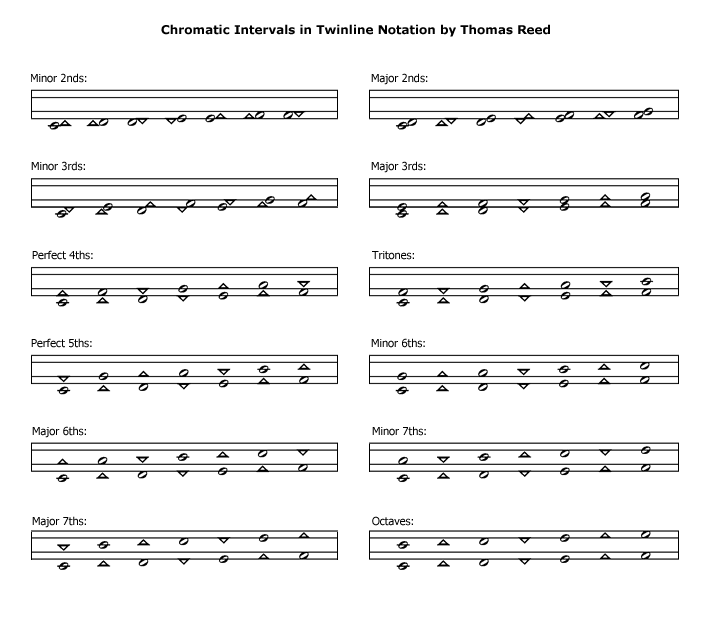
The next illustration shows how the consistency of a 6-6 pattern in notehead shape makes explicit the differences in diatonic intervals that are obscured by traditional notation.
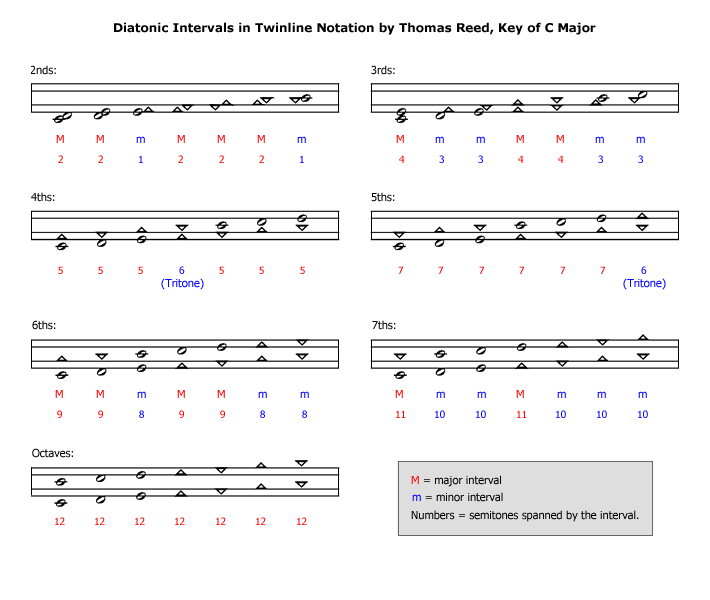
This concludes this pair of tutorials on intervals. As we have shown, traditional notation does not fully and clearly represent interval relationships, but builds interval inconsistency into its staff. Alternative notations that have a chromatic staff and a 6-6 pitch pattern do a much better job representing intervals consistently, fully, and clearly, providing significant benefits for musicians.
See also the following PDF files which show scales and chords in various 6-6 and 7-5 notations: